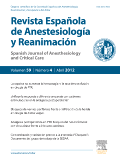
Revista Espanola de Anestesiologia y Reanimacion
Scope & Guideline
Elevating standards in critical care and pain medicine.
Introduction
Aims and Scopes
- Perioperative Management:
Research on optimizing care before, during, and after surgical procedures, focusing on patient safety, recovery protocols, and minimizing complications. - Pain Management:
Studies addressing various techniques and medications for effective pain control, including regional anesthesia, multimodal analgesia, and management of chronic pain conditions. - Critical Care and Resuscitation:
Insights into the management of critically ill patients, including advanced resuscitation techniques, fluid management, and monitoring of vital functions. - Anesthesia Techniques and Innovations:
Exploration of new anesthesia methods, equipment, and technologies, including ultrasound-guided procedures and novel drug applications. - COVID-19 Impact and Management:
Research focusing on the implications of the COVID-19 pandemic on anesthesiology practices, including adaptations in protocols and patient management. - Educational Strategies and Guidelines:
Discussions on training, competency assessments, and the development of clinical guidelines to enhance the practice of anesthesiology.
Trending and Emerging
- Enhanced Recovery After Surgery (ERAS) Protocols:
There is a rising trend in studies evaluating ERAS protocols, aiming to improve postoperative recovery through evidence-based practices and multidisciplinary approaches. - Telemedicine and Digital Tools in Anesthesiology:
Emerging research on the use of telemedicine for preoperative assessments and follow-ups is gaining traction, reflecting the adaptation to modern healthcare delivery models. - Personalized Anesthesia Approaches:
An increasing focus on tailoring anesthesia strategies to individual patient needs, considering factors such as genetics, comorbidities, and specific surgical requirements. - Impact of COVID-19 on Anesthesia Practices:
Ongoing research into the long-term effects of the COVID-19 pandemic on anesthetic practices, including adaptations in protocols, patient management, and healthcare systems. - Innovations in Pain Management Techniques:
Emerging studies exploring novel approaches to pain management, including new analgesic modalities, regional anesthesia techniques, and the use of adjuvants.
Declining or Waning
- Traditional Anesthesia Techniques:
Research focusing solely on conventional anesthesia methods has decreased, as there is a growing emphasis on innovative techniques and personalized approaches. - Basic Anesthesia Monitoring:
Interest in standard monitoring practices has waned, with more focus shifting towards advanced monitoring technologies and their applications in complex cases. - General Anesthesia for Routine Procedures:
There is a noticeable decline in studies emphasizing general anesthesia for routine surgeries, as more attention is being directed towards regional anesthesia and sedation techniques. - Non-Surgical Pain Management Approaches:
Research on non-surgical pain management strategies has diminished, likely due to the increasing focus on interventional techniques and multimodal approaches. - Pediatric Anesthesia Research:
While still relevant, the volume of research specifically targeting pediatric anesthetic practices has decreased compared to adult-focused studies.
Similar Journals
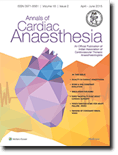
Annals of Cardiac Anaesthesia
Exploring the Frontiers of Cardiac Anaesthesia.Annals of Cardiac Anaesthesia is a distinguished open-access journal published by Wolters Kluwer Medknow Publications since 2008, focusing on the interplay between anaesthesia practices and cardiovascular health. With an ISSN of 0971-9784 and an E-ISSN of 0974-5181, this journal serves as a vital resource for researchers, practitioners, and students in the fields of Anesthesiology, Cardiology, and Medicine. Operating in India and contributing significantly to the global medical community, it ranks in the Q3 category for both Anesthesiology and Pain Medicine, as well as Cardiology and Cardiovascular Medicine, reflecting its growing impact within these domains. The journal encompasses a wide array of topics, from surgical anaesthesia techniques to cardiovascular physiology, aiming to enhance clinical practice and outcomes. With Scopus rankings placing it at 75th in Anesthesiology and 267th in Cardiology, Annals of Cardiac Anaesthesia strives to foster knowledge exchange and innovation, making it an essential platform for those committed to advancing cardiac anaesthesia science.
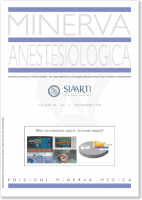
Minerva Anestesiologica
Elevating Pain Management Through Peer-Reviewed ExcellenceMinerva Anestesiologica, published by EDIZIONI MINERVA MEDICA, is a premier journal in the field of anesthesiology and pain medicine, with a commendable impact factor and classified in the second quartile (Q2) for 2023. Since its inception in 1953, this esteemed journal has served as a vital resource for researchers, clinicians, and students, presenting high-quality peer-reviewed articles that address a wide range of topics within the domain of anesthesiology. With its current ranking of #42 out of 136 in the Scopus database, Minerva Anestesiologica is recognized for its contribution to advancing clinical practices and innovations in pain management, furthering the knowledge base and professional development in anesthesiology. Although the journal is not open access, it provides comprehensive accessibility options for institutions and individual practitioners, ensuring that critical research is disseminated widely. As it continues to thrive, Minerva Anestesiologica remains a cornerstone of knowledge and a platform for transformative dialogue in the evolving landscape of anesthetic care.

Current Anesthesiology Reports
Exploring the Frontiers of Pain MedicineCurrent Anesthesiology Reports is a prominent journal published by Springer Nature, dedicated to advancing the field of anesthesiology and pain medicine. With a focus on the latest clinical and research developments, this journal serves as a vital resource for researchers, clinicians, and students alike. As of 2023, it holds a respectable Q2 quartile ranking in its category, highlighting its impact and relevance within the discipline, while also ranking 59th out of 136 in Scopus, placing it in the 56th percentile for anesthesiology and pain medicine. The journal is indexed with the E-ISSN 2167-6275 and offers an open-access model that enhances visibility and accessibility of knowledge across the global medical community. Spanning research from 2013 to 2024, Current Anesthesiology Reports aims to contribute significantly to the understanding and practice of anesthesiology, reflecting the rapidly evolving landscape of the discipline.
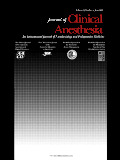
Journal of Clinical Anesthesia
Advancing Anesthesia: Pioneering Research for Patient SafetyWelcome to the Journal of Clinical Anesthesia, a premier publication in the field of anesthesiology and pain medicine, published by Elsevier Science Inc. Established in 1988, this esteemed journal serves as a vital resource for clinicians, researchers, and students, showcasing cutting-edge research and advancements in anesthesia practice and patient care. With an impressive impact factor and ranked in the Q1 category in its field, the journal is recognized for its rigorous peer-review process and high academic standards, reflecting its position at the forefront of anesthesiology research (Rank #16/136 in Scopus). Although it does not offer open access, the Journal of Clinical Anesthesia remains a crucial platform for disseminating innovative findings that shape the future of anesthesia. Located in the United States, it not only addresses contemporary challenges in the practice but also aims to foster an international dialogue among professionals dedicated to improving surgical outcomes and patient safety.
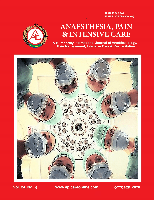
Anaesthesia Pain & Intensive Care
Advancing knowledge in anesthesiology and critical care.Anaesthesia Pain & Intensive Care is an esteemed, open-access journal that has been at the forefront of disseminating pivotal research since 1999. Published by ANAESTHESIA PAIN & INTENSIVE CARE, this journal focuses on the critical fields of anesthesiology, pain management, and intensive care medicine, engaging a diverse audience of researchers, healthcare professionals, and students. Operating from Islamabad, Pakistan, it aims to foster knowledge exchange and innovative practices within its community. With a reputation indexed in Scopus and categorized in the fourth quartile for both anesthesiology and critical care, the journal provides a platform for emerging ideas and findings, inviting contributions that enhance the global discourse in these vital areas of medicine. For those seeking to stay at the forefront of clinical advancements, Anaesthesia Pain & Intensive Care is a valuable resource, promoting open access to ensure that critical information is available to all stakeholders.
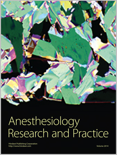
Anesthesiology Research and Practice
Empowering the medical community through accessible research.Anesthesiology Research and Practice, a prestigious open access journal published by HINDAWI LTD, serves as a vital platform for the dissemination of cutting-edge research in the fields of anesthesiology, pain medicine, and critical care. Since its inception in 2008, the journal has established itself as a key resource for researchers, clinicians, and students in the medical community, evidenced by its Q2 ranking in both Anesthesiology and Pain Medicine and Critical Care and Intensive Care Medicine. With a diverse range of articles covering innovative techniques, clinical studies, and reviews, the journal plays a crucial role in advancing knowledge and improving practices in anesthesiology. The accessible structure of the journal means that research is freely available, facilitating widespread impact and engagement in the pertinent fields. With a continued commitment to excellence, Anesthesiology Research and Practice is poised to make significant contributions to the field up to 2024 and beyond.
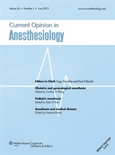
Current Opinion in Anesthesiology
Enriching Anesthesiology with Critical PerspectivesCurrent Opinion in Anesthesiology, published by LIPPINCOTT WILLIAMS & WILKINS, is a leading journal that offers critical insights and contemporary perspectives in the field of anesthesiology and pain medicine. With an ISSN of 0952-7907 and E-ISSN of 1473-6500, this journal has established itself as an influential platform since its inception in 1994, reaching its convergence in 2024. Recognized in the 2023 category quartiles as Q2 and securing an impressive rank of #37 out of 136 in Scopus, it operates at the forefront of its discipline, engaging a diverse audience of researchers, clinicians, and students. The journal aims to synthesize the latest advances and foster dialogue on emerging topics, ensuring that practitioners are equipped with the best evidence-based approaches to patient care. While it is not an open-access publication, its rigorous editorial process and commitment to quality make it a valuable resource for professionals passionate about enhancing their knowledge and practice in anesthesiology.
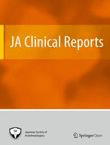
JA Clinical Reports
Elevating Standards in Anesthesiology and Pain ResearchJA Clinical Reports is a premier open access journal focusing on the fields of anesthesiology and pain medicine, published by Springer, a well-respected name in academic publishing. Since its inception in 2015, the journal has strived to disseminate high-quality research and clinical findings, making significant contributions to the understanding and treatment of pain and anesthesia. With an ISSN of 2363-9024, JA Clinical Reports is committed to advancing the field through innovative research, case reports, and comprehensive reviews, all available to a global audience without subscription barriers. As reflected in its recent Q3 quartile ranking and position at #86/136 in the Scopus database for anesthesiology and pain medicine, the journal plays a crucial role in fostering dialogue and collaboration among researchers, clinicians, and educators. This journal aims to bridge the gap between clinical practice and research, ensuring that up-to-date and relevant information is accessible to all, ultimately improving patient outcomes and fostering advances in the discipline.

ACTA ANAESTHESIOLOGICA BELGICA
Advancing Anesthesia: Bridging Research and PracticeACTA ANAESTHESIOLOGICA BELGICA, ISSN 0001-5164, is a prestigious academic journal published by ACTA MEDICAL BELGICA, dedicated to the field of anesthesiology and pain medicine. Established in the 1950s, this journal has continued to serve as a vital platform for disseminating innovative research and evidence-based practices within the discipline. Though currently positioned in the Q4 quartile in both Anesthesiology and Pain Medicine categories, it still plays a significant role in advancing knowledge and bridging gaps related to anesthesia techniques, outcomes, and patient safety. The journal is available in both print and electronic formats, with an E-ISSN of 2736-5239. Operating from Brussels, Belgium, ACTA ANAESTHESIOLOGICA BELGICA fosters an inclusive community of researchers, clinicians, and students, all dedicated to enhancing patient care and safety through the sharing of impactful findings and clinical insights.
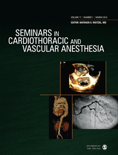
Seminars in Cardiothoracic and Vascular Anesthesia
Exploring the Frontiers of Vascular AnesthesiaSeminars in Cardiothoracic and Vascular Anesthesia, published by SAGE Publications Inc, is a leading journal dedicated to advancing the field of anesthesiology, particularly in cardiothoracic and vascular procedures. Established in 1997, this journal provides a platform for professionals, researchers, and students engaged in medical practices related to anesthesia and cardiovascular medicine. With a respected impact factor and recognized within Scopus ranks—placing it in the Q2 category for Anesthesiology and Pain Medicine and Q3 for Cardiology and Cardiovascular Medicine, the journal fosters a rigorous academic discourse aimed at improving patient outcomes and advancing clinical practices. Although it does not offer open access, its comprehensive content includes the latest research, review articles, and case studies that reflect evolving trends and innovations in the field. By providing valuable insights and a collaborative platform, Seminars in Cardiothoracic and Vascular Anesthesia plays a crucial role in disseminating knowledge and bridging gaps between research and clinical application.